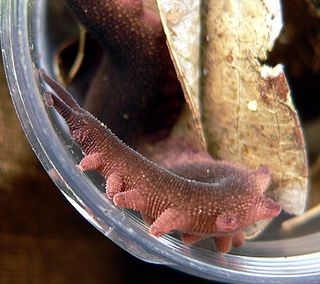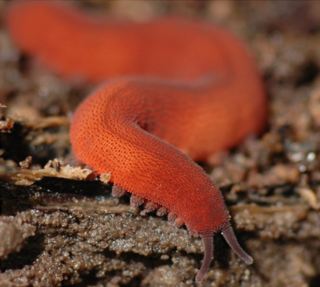
Peripatus is a genus of velvet worms in the Peripatidae family. The name "peripatus" is also used to refer to the Onychophora as a whole, although this group comprises many other genera besides Peripatus. The genus Peripatus is found in Central America, the Caribbean and northern South America. This genus is viviparous, with mothers supplying nourishment to their embryos through a placenta.

Eoperipatus is a genus of velvet worms in the family Peripatidae. These velvet worms have been reported from locations throughout Southeast Asia, including Malaysia, Singapore, Thailand, and Vietnam. This genus exhibits lecithotrophic ovoviviparity; that is, mothers in this genus retain yolky eggs in their uteri.

Epiperipatus is the most diverse genus of neotropical velvet worms in the family Peripatidae. Species in this genus are found in Central and South America. This genus is viviparous, with mothers supplying nourishment to their embryos through a placenta.

Eoperipatus totoro is a species of velvet worm of the family Peripatidae. This species is notable as the first velvet worm from Vietnam to be formally described. As of 2023, E. totoro remains the only species of velvet worm from Vietnam to be described.
Metaperipatus is a genus of velvet worms in the family Peripatopsidae that contains two species found in Chile, including Metaperipatus inae. This genus was created by the American zoologist Austin Hobart Clark in 1913 to contain the type species, M. blainvillei. Authorities believe M. blainvillei is a species complex, however, and some consider M. blainvillei a nomen dubium.
Epiperipatus betheli is a species of velvet worm in the family Peripatidae. The original description of this species is based on a dark brown female specimen, 34 mm long, with 30 pairs of legs. The type locality is in Guatemala.
Epiperipatus cratensis is a species of velvet worm in the family Peripatidae. This species is found in northeastern Brazil. This velvet worm is notable as a small species of Epiperipatus with many legs.
Epiperipatus hilkae is a species of velvet worm in the Peripatidae family. This species is found in Costa Rica. This velvet worm is closely related to another species of Epiperipatus found in Costa Rica, E. isthmicola. The species E. hilkae is named in honor of the German zoologist Hilke Ruhberg for her extensive work on velvet worms.
Heteroperipatus clarki is a species of velvet worm in the Peripatidae family. Females of this species have 26 to 29 pairs of legs. The original description of this species is based on a female specimen measuring 100 mm in length. The type locality is in Panama.
Oroperipatus ecuadoriensis is a species of velvet worm in the Peripatidae family. The original description of this species is based on a female specimen notable for its large size ; this description also reports 39 pairs of legs. The type locality is in Ecuador.
Oroperipatus lankesteri is a species of velvet worm in the Peripatidae family. This velvet worm is notable for its large size, reaching 82 mm in length. This species is known only from its type locality in the northern Pacific lowlands of Ecuador.
Oroperipatus peruvianus is a species of velvet worm in the Peripatidae family. Males of this species have 34 pairs of legs; females have 36 or 37. Female specimens range from 55 mm to 61 mm in length. The type locality is in Peru.
Peripatus evelinae is a species of velvet worm in the Peripatidae family. The male of this species has 33 pairs of legs; females have 35 or 36 leg pairs. This species has more legs than any other species of Peripatus; the females of the other species have at most 34 leg pairs, and the males have at most 32. The original description of P. evelinae was based on two specimens and reported females with 32 and 34 leg pairs, but another examination of these specimens revealed a male with 33 leg pairs and a female with 35 leg pairs instead as well as numerous embryos, including females with 35 and 36 leg pairs. The male specimen is 44 mm long; the female is 65 mm long. The type locality is in Goiás, Brazil.

Peripatus juanensis is a species of velvet worm in the Peripatidae family discovered in Puerto Rico in 1900. As of 2018, it is the only velvet worm found in Puerto Rico. Females of this species have 31 or 32 pairs of legs; males have 27.

Peripatus juliformis is a species of velvet worm in the Peripatidae family. The number of legs in this species ranges from 29 pairs to 34 pairs. Specimens are a very dark brown, almost black, with a paler ventral surface. Females range from 36 mm to 75 mm in length, whereas males range from 14 mm to 16 mm. The type locality is on Saint Vincent Island.
Mongeperipatus solorzanoi, also known as Solórzano's velvet worm, is a species of velvet worm in the family Peripatidae. This species is the largest known velvet worm, reaching 22 cm in length. This velvet worm is found in the Caribbean coastal forest of Costa Rica.
Peripatopsis sedgwicki is a species of velvet worm in the Peripatopsidae family. Also known as the Tsitsikamma velvet worm, this species has a narrow geographic distribution in South Africa but is especially abundant in the indigenous forest of the Tsitsikamma mountains. Recent phylogenetic analysis suggests that Peripatopsis sedgwicki is a species complex that contains three clades, each with a distinct geographic distribution, including at least one clade that may represent a novel species.
Ooperipatellus nickmayeri is a species of oviparous velvet worm in the family Peripatopsidae. This species is larger than any other in the genus Ooperipatellus. With a body size exceeding 60 mm in females and 30 mm in males, these velvet worms can be more than twice as long as other species of this genus.
Epiperipatus hyperbolicus is a species of velvet worm in the family Peripatidae. This velvet worm is known only from its type locality in the state of Alagoas in Brazil. The species name refers to the unusually large apical piece on the primary papillae on this velvet worm. This distinctive apical piece is notable for its size and spherical shape. The males of this species have 23 pairs of legs; females have 24 or 25 pairs.
Epiperipatus titanicus is a species of velvet worm in the family Peripatidae. This velvet worm is known only from its type locality in the state of Alagoas in Brazil. The species name refers to the large size of its females and its numerous legs. This species features more legs than any other Brazilian species of velvet worm.




